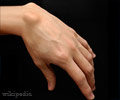When it comes to cancerous mutations, cells in soft tissues exhibit fewer irregularities than their stiffer somatic brethren in the lungs or bone.

‘Tumors arising in stiff tissues, such as the human lung and bone, exhibit mutation rates and chromosome variations around 100 times higher than those in soft tissues, such as marrow and brain.’





"Basically, we hypothesize that stiffer tissues with their denser matrix and smaller constrictions cause more nucleus deformation that damages the nucleus," said Jerome Irianto, a postdoctoral researcher in the lab of Dennis E. Discher, Director of the Physical Sciences in Oncology Center at UPenn. Irianto and his colleagues present their work this week at the Biophysical Society's 60th Annual Meeting in Los Angeles, CA. To examine this, the researchers had two cancer cell lines - one derived from lung tissue and the other from bone - migrate through thin plastic filters with 3-micrometer pores that are only about one-fifth of the diameter of the nuclei. When the cells migrate and force their way through the pores over a 24-hour period, they deform and accumulate DNA damage; larger, 8-micrometer pores do not cause such damage.
In further experiments, the researchers expressed in these cells DNA repair proteins that usually diffuse around the DNA to search out breaks. Then they pulled individual nuclei into small pores to mimic the migration and observed what happened by tagging the repair proteins with green fluorescent protein.
Irianto said, "Imagine modeling the DNA as threads in a small cotton ball that is squeezed into a small see-through straw. The air that makes the cotton ball fluffy will be squeezed out. We think that such compaction reduces porosity and severely limits the mobility of protein to follow the DNA." This nuclear constriction - with local deficits in DNA repair factors - should reduce the repair rate, and thus increase mutation rates.
Irianto said, "What we are addressing right now is whether this constricted migration with molecular damage and segregation will translate to genomic instability, which is a 'hallmark' of cancer. Cancer needs to invade to spread, and that invasion could itself cause mutations."
Advertisement












